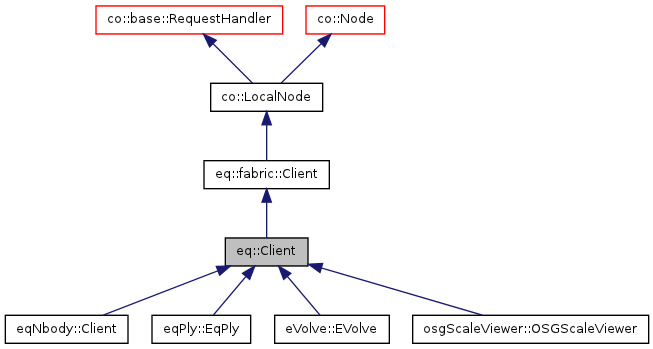|
Equalizer 1.0
|
eq::Client Class Reference
The client represents a network node of the application in the cluster. More...
#include <client.h>
 Inheritance diagram for eq::Client:
Inheritance diagram for eq::Client: Collaboration diagram for eq::Client:
Collaboration diagram for eq::Client:Public Member Functions | |
| Client () | |
| Construct a new client. | |
| virtual | ~Client () |
| Destruct the client. | |
| bool | connectServer (ServerPtr server) |
| Open and connect an Equalizer server to the local client. | |
| bool | disconnectServer (ServerPtr server) |
| Disconnect and close the connection to an Equalizer server. | |
| virtual bool | initLocal (const int argc, char **argv) |
| Initialize a local, listening node. | |
| bool | hasCommands () |
| virtual co::CommandQueue * | getMainThreadQueue () |
Protected Member Functions | |
| virtual void | clientLoop () |
| Implements the processing loop for render clients. | |
| virtual void | exitClient () |
| Exit the process cleanly on render clients. | |
Detailed Description
The client represents a network node of the application in the cluster.
The methods initLocal() and exitLocal() should be used to set up and exit the listening node instance for each application process.
- See also:
- fabric::Client for public methods
Definition at line 38 of file include/eq/client.h.
Constructor & Destructor Documentation
| eq::Client::Client | ( | ) |
| virtual eq::Client::~Client | ( | ) | [virtual] |
Destruct the client.
- Version:
- 1.0
Reimplemented from eq::fabric::Client.
Reimplemented in eqNbody::Client.
Member Function Documentation
| virtual void eq::Client::clientLoop | ( | ) | [protected, virtual] |
Implements the processing loop for render clients.
As long as the node is running, that is, between initLocal() and an exit send from the server, this method executes received commands using processCommand() and triggers the message pump between commands.
- See also:
- Pipe::createMessagePump()
- Version:
- 1.0
Reimplemented in eqPly::EqPly, and eVolve::EVolve.
Referenced by eVolve::EVolve::clientLoop().
 Here is the caller graph for this function:
Here is the caller graph for this function:| bool eq::Client::connectServer | ( | ServerPtr | server | ) |
Open and connect an Equalizer server to the local client.
The client has to be in the listening state, see initLocal().
- Parameters:
-
server the server.
- Returns:
- true if the server was connected, false if not.
- Version:
- 1.0
Referenced by osgScaleViewer::OSGScaleViewer::run(), and eqPly::EqPly::run().
 Here is the caller graph for this function:
Here is the caller graph for this function:| bool eq::Client::disconnectServer | ( | ServerPtr | server | ) |
Disconnect and close the connection to an Equalizer server.
- Parameters:
-
server the server.
- Returns:
- true if the server was disconnected, false if not.
- Version:
- 1.0
Referenced by osgScaleViewer::OSGScaleViewer::run(), and eqPly::EqPly::run().
 Here is the caller graph for this function:
Here is the caller graph for this function:| virtual void eq::Client::exitClient | ( | ) | [protected, virtual] |
Exit the process cleanly on render clients.
- Version:
- 1.0
| virtual co::CommandQueue* eq::Client::getMainThreadQueue | ( | ) | [inline, virtual] |
- Returns:
- the command queue to the main node thread.
Implements eq::fabric::Client.
Definition at line 90 of file include/eq/client.h.
| bool eq::Client::hasCommands | ( | ) |
- Returns:
- true if the client has commands pending, false otherwise.
- Version:
- 1.0
Referenced by eqPly::EqPly::run().
 Here is the caller graph for this function:
Here is the caller graph for this function:| virtual bool eq::Client::initLocal | ( | const int | argc, |
| char ** | argv | ||
| ) | [virtual] |
Initialize a local, listening node.
The --eq-client command line option is recognized by this method. It is used for remote nodes which have been auto-launched by another node, e.g., remote render clients. This method does not return when this command line option is present.
- Parameters:
-
argc the command line argument count. argv the command line argument values.
- Returns:
trueif the client was successfully initialized,falseotherwise.
- Version:
- 1.0
Reimplemented from co::LocalNode.
The documentation for this class was generated from the following file:
 1.0 by
1.0 by
 1.7.3
1.7.3





